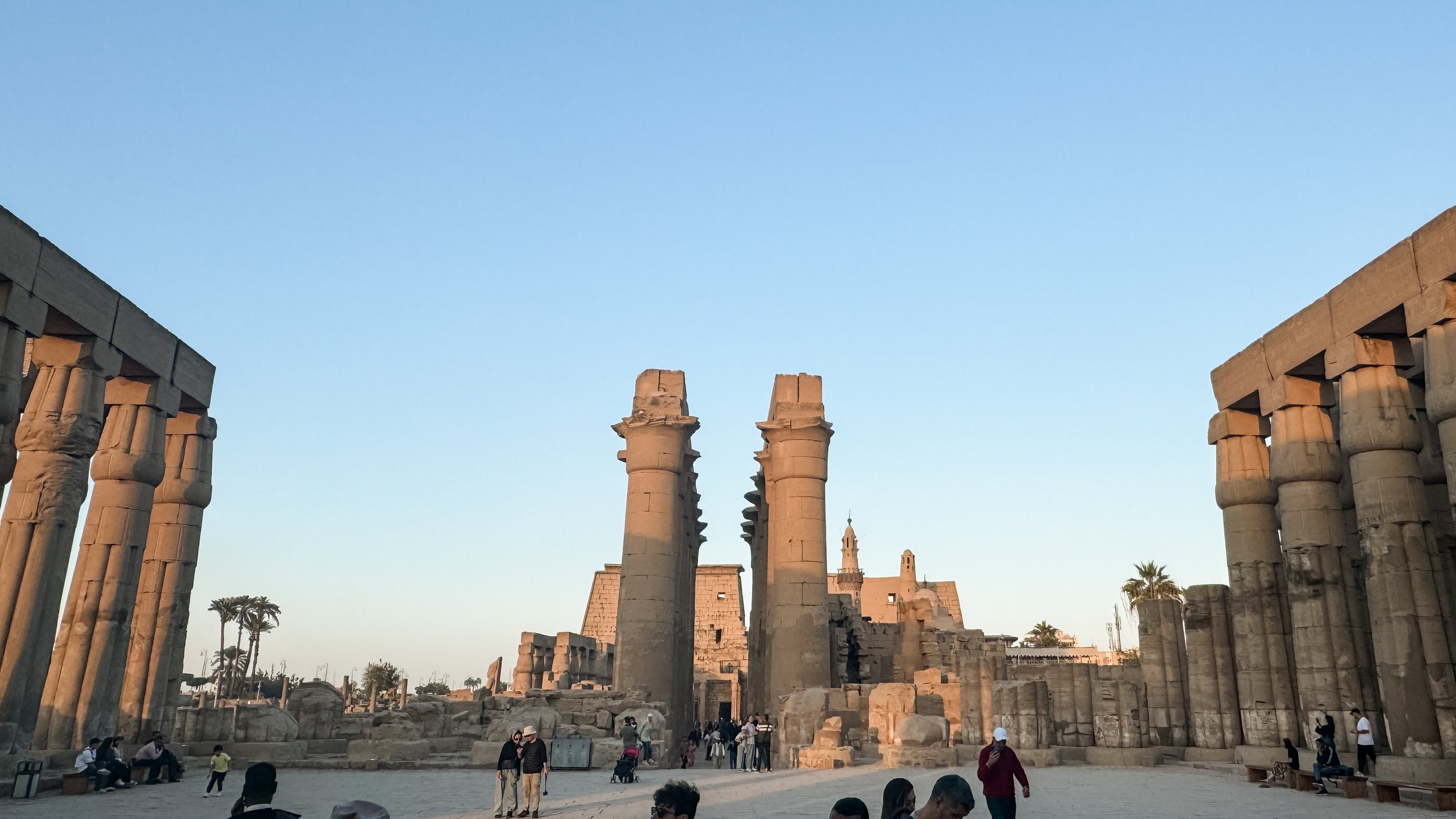Luxor, once known as the ancient city of Thebes, was the captial of Egypt from 1570 BCE to 1069 BCE. Like most of Egypt, The Nile flows right through Luxor, dividing it into the East Bank and The West Bank. The East Bank is where you’ll find mots of the large hotels, shops, residential areas and two of the most important sights of Ancient Egypt; Karnak Temple and Luxor Temple.
We arrived in Luxor in the afternoon, after our driver from Memphis Tours transported us by Mini Van from Hurghada. The Drive took around 3 hours and we drove though some very barren, desert landscapes.
Unfortunately, Hallie and Rooney came down with feverish, flu like symptons on this day, so by the time we reached the hotel in Luxor, The Sonesta St George, they were in no state to head out sightseeing. Braino stayed at the accommodation while they slept and Farley and I headout with our guide LT to visit Karnak Temple and Luxor Temple. As sad as it was that two of the three girls were sick, it was still a lovely afternoon, spending some one on one time with Farley.
Karnak Temple
Dating from around 2055 BC to around 100 AD, the Karnak Temple Complex is a collection of temples, chapels, pylons, and other structures, making it one of the largest religious complexes ever built.
Inside the Karnak Temple Complex, the Precinct of Amun-Ra, is the only part that most visitors get to see. The other three parts, the Precinct of Mut, the Precinct of Montu, and the dismantled Temple of Amenhotep IV, are not open to the public.
The most impressive area is the The Great Hypostyle Hall, where the awe-inspiring towering columns soar towards the heavens. The other iconic sights to look out for are the Obelisk of Thutmose I and Queen Hatshepsut along with many huge statues of Ramses II.
Our guide, LT was a qualified Archeologist and Egyptologist and had so much knowledge to share. He also specialised in spiritual tours and had worked on film shoots as a historical consultant including The Scorpion King with Dwayne ‘The Rock’ Johnson. He was such an interesting character and was very proactive at offering to take our photo, which is always lovely. I actually didn’t get any photos with him.
First Pylon of Karnak Temple
Obelisks of Thutmose I & Queen Hatshepsut.
The Great Hypostyle Hall
The Great Hypostyle Hall
The Great Hypostyle Hall
The Great Hypostyle Hall
Aries Sphinx Statues in the Great Court
Luxor Temple
After Karnak Temple, we headed to Luxor Temple, which is only a short 2km drive away. There is an Avenue of Sphinx Statues that once linked Karnak Temple and Luxor Temple.
Farley, LT and I arrived as the sun was setting but were surprised to find the crowded were still quite thick. LT mentioned that these crowds were nothing compared to amount of people who visit between Christmas and New Years. Visitors would have to line up for hours just to enter the temples. No Thanks! I’m glad we had missed those sort of crowds by a couple of days
Luxor Temple resembles a smaller version of Karnak Temple and was built by Amenhotep III (1390-52 BC) but completed by Tutankhamun (1336-27 BC) and Horemheb (1323-1295 BC) and then added to by Rameses II (1279-13 BC). The Temple interestingly has evidence of Christian worship and remains of a Coptic church. There is also a Mosque that was built on top of the Temple while it was still buried under the sand. It has been preserved and still stands to this day.
The front of Luxor Temple is guarded by 6 statues of Rameses II - two seated and four standing. Originally two 85m tall obelisk stood on either side of the entrance but one only remains today, the other can now be seen at the Place De La Concorde in Paris.
Avenue of Sphinx
Luxor Temple
Luxor Temple
Luxor Temple
Luxor Temple
Luxor Temple
Luxor Temple
If I could choose a super power, I would want to be able to go back in time to see ancient sites in all their splendour . Or to the late 1800s, when these temples were half buried in the sands of time, before any one saw the value in excavating the ruins of the past. Karnak Temple and Luxor Temple are magnificant in their current states, it’s hard to imagine what they would have looked like over 3000 years agao. Even with the crowded they still have an ethereal, otherworldly vibe, that makes you marvel at history and the evolution of civilisations. I felt very proud to be able to return to Egyot and share the experience of visiting these temples with Farley, 18 years after visiting them for the first time.













